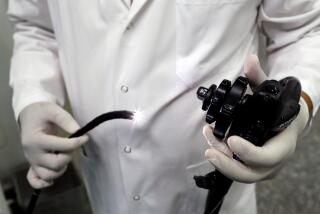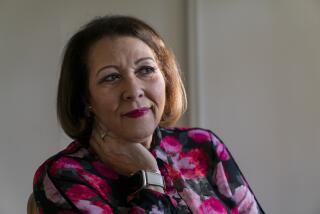Getting to the facts in the debate on mammograms
It’s such an appealing idea -- catch breast cancer early, treat accordingly and your patients will live.
So perhaps it’s no wonder the U.S. Preventive Services Task Force -- a panel of primary care physicians -- caught major flak when it revised its guidelines to say most women don’t need mammograms until they turn 50, and thereafter every other year. Previously the recommendations had been to start getting mammograms at age 40, and then every one or two years.
The new guidelines were met with a maelstrom of impassioned reaction from doctors. Many advocacy groups bemoaned the panel’s findings, and the American Cancer Society said it would stand by its current recommendations: that women get annual mammograms starting at age 40. “There is no question that the American Cancer Society is going to stay put and is reacting strongly against the new guidelines,” says board member Dr. Christy Russell, director of USC’s Norris Breast Center.
But other doctors say that it’s about time there was a clearheaded analysis weighing the benefits and risks.
“I think the [new] guidelines are great,” says Dr. Susan Love, a breast cancer surgeon at UCLA’s David Geffen School of Medicine and author of “Dr. Susan Love’s Breast Book.” “They finally bring us into line with everyone else in the world. They’re based on data, as opposed to wishful thinking.”
FOR THE RECORD: An earlier version of this article incorrectly referred to Dr. Anne Wallace, director of the Moores UC San Diego Breast Cancer Program, as Amy Wallace.
Somewhat lost in the fracas is the fact that the task force was not suggesting all women under 50 eschew mammograms: The recommendations did not apply to women at high risk for breast cancer.
Here’s a closer look at some of the risk factors and what mammography can and can’t do for women.
All doctors agree that mammography is the best test we have and it does save lives, says Dr. Eric Winer, a breast cancer doctor at the Dana-Farber Cancer Institute in Boston and chief scientific advisor of the advocacy organization Susan G. Komen for the Cure. “Where there’s disagreement is at exactly what age to start and exactly how often to do a mammogram,” he says.
Screening for cancer makes more sense in patients with higher risk for disease -- and the strongest risk factor for breast cancer is age. A 40-year-old woman has a 1.4% chance of getting breast cancer by the time she is 50, according to data from the U.S. Centers for Disease Control and Prevention, whereas a 50-year-old has a 2.4% chance over her next decade and a 60-year-old has a 3.4% chance.
But age is only one risk factor. “Women with a family history, women with an abnormal breast biopsy in the past and patients with previous history of breast cancer -- those are the patients you’d want to screen early and regularly,” says Dr. Shelley Hwang, chief of breast surgical oncology at UC San Francisco, who welcomes the new guidelines. Family history means a parent, sibling or child who has the disease; risk is especially heightened if that family member developed the disease before age 50.
In addition, early menstruation (before age 12) and late pregnancies (after age 30 or not at all) have been associated with higher risks of breast cancer, as have obesity and lack of physical exercise, according to the National Cancer Institute.
Mammograms are better at detecting breast cancer in older women than in younger women because of normal changes that happen in breast tissue with aging. At younger ages, including the 40s, women have denser breasts, which leaves radiologists looking for solid white spots against an already-white background. “I liken it to looking for a polar bear in a snowstorm,” Hwang says. “The older you get, the less snow there is, so the more likely you are to pick out the polar bear.”
In short, mammograms are a better screening test as women get older and as their risk of developing cancer increases. “The reason that 50 works out to be the best time to [test] is because all these things come together around 50,” Love says.
On the flip side, women who develop breast cancer in their 40s are more likely to have fast-growing cancers -- a fact that makes many doctors squeamish about an end to blanket screening of that group, even those who agree that screening has been oversold.
“I’m a middle-of-the-road person,” says Dr. Anne Wallace, director of the Moores UC San Diego Breast Cancer Program. “But [it’s] in women ages 40 to 49 that we sometimes find the nasty-biology tumors very early” -- cancers that 10 years later would be very aggressive and hard to treat.
So if that’s the case, what’s the harm in screening everyone? Mammography is not a perfect test, for one. A scan can fail to detect something that is disease, which can leave women and their doctors with a false sense of security and cause them to be less vigilant about changes to the breast. “And it misses a lot, in younger women,” Love says.
Second -- and here’s where the risks of screening really come in -- it can detect something that isn’t disease. “When we find something solid, that is automatically considered suspicious and needs a biopsy,” Wallace says.
The procedure entails removing tissue or fluid from the lump. But the problem doesn’t end there. Beyond the biopsy, sometimes women end up being treated for cancers that would never have become aggressive and threatened their lives.
Biopsies can also find atypical cells that are considered precancerous. “Sometimes, diagnosing these precancerous conditions results in more women doing something very aggressive just to reduce their anxiety about developing breast cancer,” Hwang says. She has had patients who had elective bilateral mastectomies after precancers were found, rather than face the risk of developing a full-blown cancer.
The task force calculated that among women in their 40s, 1,900 must be screened to save one life. They also cite studies that estimate the risk of getting a false positive scan after 10 mammograms as ranging from 21% to 56%.
Balancing those harmed with those saved leaves physicians with a dilemma. “It gets down to how many women is it OK to [have] die -- this is what’s heartbreaking to me,” Wallace says. “I’ve always known we’re not meeting big statistics in this age group, but we definitely are saving some lives.”
If doctors can’t make up their minds about screening, how can women?
Some doctors say they will take advantage of the current dust-up to have careful conversations with their patients about the risks and benefits of screening in the context of patients’ own risk profiles.
“I think that should happen anyway,” Wallace says. “A check-off system of ‘Are you getting all your screenings?’ shouldn’t be the way primary care practices.”
To learn more about factors that determine a woman’s individual risk of breast cancer, go to the National Cancer Institute, which has a breast cancer risk assessment tool (www.cancer.gov/bcrisktool) and a mammogram fact sheet (www.cancer.gov/cancertopics/factsheet/Detection/mammograms).






